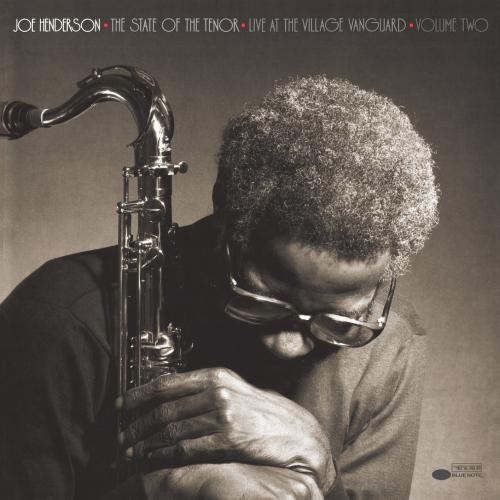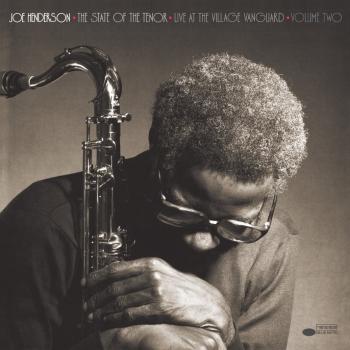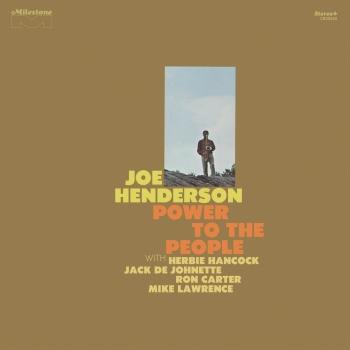
The State Of The Tenor (Remastered) Joe Henderson
Album info
Album-Release:
2019
HRA-Release:
03.05.2019
Album including Album cover
I`m sorry!
Dear HIGHRESAUDIO Visitor,
due to territorial constraints and also different releases dates in each country you currently can`t purchase this album. We are updating our release dates twice a week. So, please feel free to check from time-to-time, if the album is available for your country.
We suggest, that you bookmark the album and use our Short List function.
Thank you for your understanding and patience.
Yours sincerely, HIGHRESAUDIO
- 1 Boo Boo's Birthday (Live) 07:08
- 2 Cheryl (Live) 07:42
- 3 Y Ya La Quiero (Live) 06:42
- 4 Soulville (Live) 05:38
- 5 Portrait (Live) 07:06
- 6 The Bead Game (Live) 09:45
Info for The State Of The Tenor (Remastered)
From November 14 to 16 in 1985, the Joe Henderson trio held court at the Village Vanguard for a legendary 10-set engagement, some of which was recorded for Blue Note and released in 1986 as two volumes under the declarative banner The State of the Tenor. The saxophone titan was 48 at the time, and sat comfortably at the top of the heap among his peers. The great pugilist of the instrument, his muscular approach was reflective of the brash sensibility of the '80s; the heavy hitters joining him onstage, bassist Ron Carter and drummer Al Foster, complemented Henderson's take-no-prisoners style with a sense of airy restraint, swinging big when they needed to fill in the negative space.
If Sonny Rollins was the Muhammad Ali of the tenor, Henderson was the Joe Frazier, his overpowering technique and bravado packing a knockout punch that landed squarely on the ear. He was an undeniable force, the summation of the state of the tenor at that time—the 800-pound gorilla of his era. He might not have had the lightness of touch that Rollins typified, and was no gentle giant like Dexter Gordon, but listening to Henderson was a full immersion experience, enhanced by the trio's sparse, piano-less orchestration, the same instrumentation used by Rollins in his 1957 live sessions at the same club. The trio setting suited Henderson well; he could spell out chords with a sweeping breadth of scope that left nothing unsaid.
Henderson grew up in Lima, Ohio, an acolyte of Charlie Parker, and after cutting his teeth on the local scene, made his way to Detroit, where he attended Wayne State University and studied under famed saxophone teacher Larry Teal. Some of that trademark muscularity might come from his service record; in his early twenties, Henderson enlisted in the U.S. Army, embarking on a world tour. He made his professional debut in 1963 on Blue Note, closely allied with trumpeter Kenny Dorham (they worked together on his Page One and Dorham’s Una Mas), and quickly established a reputation on the forefront of the hard bop scene, playing with Horace Silver and becoming a favorite sideman of trumpeter Lee Morgan and pianist Andrew Hill. By 1985, though, Henderson had moved firmly beyond comparisons to Rollins and his predecessors, reinterpreting standards and contributing some of his own material to the jazz firmament.
On The State of the Tenor, Henderson pays tribute to saxophone titans Sam Rivers and Charlie Parker on the gorgeous Rivers ballad "Beatrice" and the more up-tempo Parker tune "Cheryl," confidently differentiating himself from these towering influences. Henderson was hard-edged where Rivers was lush, manic and disjunctive where Parker was calm and fluid, yet he gives hints of those softer traits in his homage. "Beatrice" opens with Carter playing diffident bass chords, Foster on subtle brushwork, and Henderson at his most tremulous, a Trojan horse approach that soon gives way to his usual unsparing intensity. After a series of flurrying arpeggios exploring the full range of the tenor, Henderson softens his blows and returns to the melody.
"Cheryl" features Carter on a virtuosic, extended rubato introduction, setting the mood for an exploration of Henderson's greatest early influence. The saxophonist dives into his solo quickly, playing with a vertiginous sound and fury reminiscent of Parker in his totality, yet so utterly himself; unlike most, Henderson actually plays more notes than Parker did.
Henderson further shows his tender side on the ballads "Ask Me Now," a staple of his repertoire; "Portrait," a Mingus composition that allows him to explore the complex harmonies he was known for; and "Happy Reunion," a delicate tune that features Henderson as bull in Duke Ellington's china shop. "Ask Me Now," one of three Thelonious Monk compositions on State of the Tenor, has an intrinsic restlessness well-suited to Henderson; Monk is the only composer featured as prominently as Henderson himself here, and the two certainly have a simpatico relationship in their jarring harmonic conceits. Henderson doesn't pull any punches on these ballads—subtlety was never his stock-in-trade—and in the ballad setting, he appears fully exposed.
The other two Monk tunes, "Friday the Thirteenth" and "Boo Boo's Birthday," showcase Henderson's technical mastery as he channels Monk's playful, syncopated style. The former tune begins with a subdued Carter introduction, interrupted by the keening entrance of Henderson on the melody. From there, he telescopes outward into a storm of machine-gun runs. "Boo Boo's Birthday" further advances the theme of shock and awe—Henderson demolishes form and reconstitutes it to serve his intention. It's scorched earth of the saxophone variety.
Of the three Henderson originals, "Isotope" is the best known, but Henderson dashes through the melody instead of relishing it as others might. He takes the tune in a more radioactive direction, and it is here where his explosiveness goes nuclear. Carter and Foster respond by ratcheting up the bassline and the drum hits; they would have drowned out almost anyone else. "Y Ya La Quiero" puts Henderson in a Latin context, terrain he explored with Horace Silver. He favors trills and propulsive double-time lines opposite Carter's unwavering clave, not afraid to let the saxophone bleat. "The Bead Game" shows Henderson in his most altered state on State of the Tenor—he often served as the connective tissue between hard bop and free jazz—with Carter and Foster parrying his every move.
"Loose Change," Carter's sole compositional contribution to the album, and Silver's "Soulville" offer a glimpse into the straight-ahead hard bop playing that made Henderson's name. "Loose Change" has an understated modal quality that Henderson rains blow after punishing blow on, until he exhausts the form and Carter takes over with casual élan. Carter, Foster, and Henderson all collaborated with Silver, so "Soulville" was well-trodden hard bop territory for them. Henderson tends to play more on the beat than many of his contemporaries, but here he lags behind with a deliberate cool, the coin of Silver's artistic realm.
The two old standards, "Stella by Starlight" and "All the Things You Are," show Henderson's consummate skill. Rather than relying on reflexive facility through the many improvised choruses he takes, Henderson forges a new path through the form and makes it unequivocally his own; his "Stella" is exhaustive, and he flies aggressively over the extended introduction to "All the Things You Are," favoring an interstitial staccato style on the melody that emphasizes the fissures he loved to expound upon. Joe Henderson always punched his way through prevailing melodic structures to expose the cracks in conventional harmony, challenging institutional frameworks. Here, he brought his renegade style to the Village Vanguard, and as others had done in previous generations, redefined the state of the tenor.
Joe Henderson, tenor saxophone
Ron Carter, bass
Al Foster, drums
Recorded live at The Village Vanguard, New York City on November 14, 15 and 16, 1985
Produced by Stanley Crouch, Michael Cuscuna
Digitally remastered
Joe Henderson
is proof that jazz can sell without watering down the music; it just takes creative marketing. Although his sound and style were virtually unchanged from the mid-'60s, Joe Henderson's signing with Verve in 1992 was treated as a major news event by the label (even though he had already recorded many memorable sessions for other companies). His Verve recordings had easy-to-market themes (tributes to Billy Strayhorn, Miles Davis, and Antonio Carlos Jobim) and, as a result, he became a national celebrity and a constant poll winner while still sounding the same as when he was in obscurity in the 1970s.
The general feeling is that it couldn't have happened to a more deserving jazz musician. After studying at Kentucky State College and Wayne State University, Joe Henderson played locally in Detroit before spending time in the military (1960-1962). He played briefly with Jack McDuff and then gained recognition for his work with Kenny Dorham (1962-1963), a veteran bop trumpeter who championed him and helped Henderson get signed to Blue Note. Henderson appeared on many Blue Note sessions both as a leader and as a sideman, spent 1964-1966 with Horace Silver's Quintet, and during 1969-1970 was in Herbie Hancock's band. From the start, he had a very distinctive sound and style which, although influenced a bit by both Sonny Rollins and John Coltrane, also contained a lot of brand new phrases and ideas. Henderson had long been able to improvise in both inside and outside settings, from hard bop to freeform. In the 1970s, he recorded frequently for Milestone and lived in San Francisco, but was somewhat taken for granted. The second half of the 1980s found him continuing his freelancing and teaching while recording for Blue Note, but it was when he hooked up with Verve that he suddenly became famous. Virtually all of his recordings are currently in print on CD, including a massive collection of his neglected (but generally rewarding) Milestone dates. On June 30, 2001, Joe Henderson passed away due to heart failure after a long battle with emphysema. (Source: Blue Note Records, Scott Yanow)
" class="ng-binding ng-scope">Joe Henderson with Chick Corea
This album contains no booklet.









